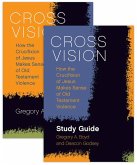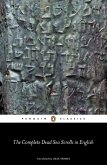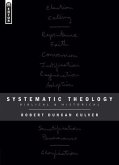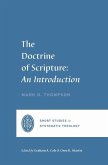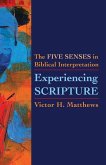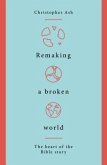133,99 €
inkl. MwSt.
Versandkostenfrei*
Erscheint vorauss. 30. Oktober 2025
Melden Sie sich
hier
hier
für den Produktalarm an, um über die Verfügbarkeit des Produkts informiert zu werden.

67 °P sammeln
- Gebundenes Buch
Builds upon and moves beyond John Webster's influential work on Scripture's ontology to construct a hermeneutical approach to scriptural interpretation.
Andere Kunden interessierten sich auch für
![Cross Vision Study Guide Bundle Cross Vision Study Guide Bundle]() A., Boyd, GregoryCross Vision Study Guide Bundle23,99 €
A., Boyd, GregoryCross Vision Study Guide Bundle23,99 €![The Complete Dead Sea Scrolls in English The Complete Dead Sea Scrolls in English]() The Complete Dead Sea Scrolls in English (7th Edition)The Complete Dead Sea Scrolls in English20,99 €
The Complete Dead Sea Scrolls in English (7th Edition)The Complete Dead Sea Scrolls in English20,99 €![Systematic Theology Systematic Theology]() Robert Duncan CulverSystematic Theology38,99 €
Robert Duncan CulverSystematic Theology38,99 €![Sam's Supersecret Survival Guide to Boxing Up Brothers, Befriending Wizards, and Moving Into a New Home Sam's Supersecret Survival Guide to Boxing Up Brothers, Befriending Wizards, and Moving Into a New Home]() Robin TwiddySam's Supersecret Survival Guide to Boxing Up Brothers, Befriending Wizards, and Moving Into a New Home32,99 €
Robin TwiddySam's Supersecret Survival Guide to Boxing Up Brothers, Befriending Wizards, and Moving Into a New Home32,99 €![The Doctrine of Scripture The Doctrine of Scripture]() Mark D. ThompsonThe Doctrine of Scripture22,99 €
Mark D. ThompsonThe Doctrine of Scripture22,99 €![Experiencing Scripture Experiencing Scripture]() Victor H. MatthewsExperiencing Scripture24,99 €
Victor H. MatthewsExperiencing Scripture24,99 €![Remaking a Broken World Remaking a Broken World]() Christopher AshRemaking a Broken World16,99 €
Christopher AshRemaking a Broken World16,99 €-
-
-
Builds upon and moves beyond John Webster's influential work on Scripture's ontology to construct a hermeneutical approach to scriptural interpretation.
Hinweis: Dieser Artikel kann nur an eine deutsche Lieferadresse ausgeliefert werden.
Hinweis: Dieser Artikel kann nur an eine deutsche Lieferadresse ausgeliefert werden.
Produktdetails
- Produktdetails
- Verlag: Bloomsbury Academic
- Seitenzahl: 224
- Erscheinungstermin: 30. Oktober 2025
- Englisch
- Abmessung: 234mm x 156mm x 25mm
- Gewicht: 454g
- ISBN-13: 9780567717351
- ISBN-10: 0567717356
- Artikelnr.: 73241656
- Herstellerkennzeichnung
- Libri GmbH
- Europaallee 1
- 36244 Bad Hersfeld
- gpsr@libri.de
- Verlag: Bloomsbury Academic
- Seitenzahl: 224
- Erscheinungstermin: 30. Oktober 2025
- Englisch
- Abmessung: 234mm x 156mm x 25mm
- Gewicht: 454g
- ISBN-13: 9780567717351
- ISBN-10: 0567717356
- Artikelnr.: 73241656
- Herstellerkennzeichnung
- Libri GmbH
- Europaallee 1
- 36244 Bad Hersfeld
- gpsr@libri.de
Jonathan Rowlands is Graduate Tutor and Lecturer in Theology at St. Mellitus College, UK
Introduction
i. A History of TIS
ii. A Taxonomy of TIS
iii. The Aims and Purposes of Reading Holy Scripture
1. Scripturely Ontology and Theological Reading
i. John Webster on Scriptural Ontology
ii. John Webster on Scriptural Hermeneutics
iii. The Need for a Mediating Position
2. The Hermeneutics of Theological Reading
i. Gadamer and Hirsch on Reading and Meaning
ii. Different Games, Competing Doxae
iii. Doxa in Practice: A Example
3. The Benefit of Theological Reading
i. The Challenges Facing Biblical Scholarship
ii. The Emergence of Reception History
iii. Reading for Truth
4. The Mood of Theological Reading
i. Heidegger, Dasein, and 'Mood'
ii. Critical Reading as a Hermeneutics of Suspicion
iii. A New Mood for Theological Reading
5. Formation and Theological Reading
i. Reading Scripture on the Road to Emmaus
ii. Prayer and Theological Speech
6. Reading the Old Testament Theologically
i. Defining Terms
ii. Finding the Trinity in Jewish Scripture
7. Historiography and Theological Reading
i. Bultmann, History, and Theology
ii. Re-integrating History and Theology
8. Sachkritik and Theological Reading
i. Defining Sachkritik
ii. Decrying Sachkritik
iii. Defending Sachkritik
Conclusion
i. Summary of the Arguments Made
ii. What Next for TIS?
i. A History of TIS
ii. A Taxonomy of TIS
iii. The Aims and Purposes of Reading Holy Scripture
1. Scripturely Ontology and Theological Reading
i. John Webster on Scriptural Ontology
ii. John Webster on Scriptural Hermeneutics
iii. The Need for a Mediating Position
2. The Hermeneutics of Theological Reading
i. Gadamer and Hirsch on Reading and Meaning
ii. Different Games, Competing Doxae
iii. Doxa in Practice: A Example
3. The Benefit of Theological Reading
i. The Challenges Facing Biblical Scholarship
ii. The Emergence of Reception History
iii. Reading for Truth
4. The Mood of Theological Reading
i. Heidegger, Dasein, and 'Mood'
ii. Critical Reading as a Hermeneutics of Suspicion
iii. A New Mood for Theological Reading
5. Formation and Theological Reading
i. Reading Scripture on the Road to Emmaus
ii. Prayer and Theological Speech
6. Reading the Old Testament Theologically
i. Defining Terms
ii. Finding the Trinity in Jewish Scripture
7. Historiography and Theological Reading
i. Bultmann, History, and Theology
ii. Re-integrating History and Theology
8. Sachkritik and Theological Reading
i. Defining Sachkritik
ii. Decrying Sachkritik
iii. Defending Sachkritik
Conclusion
i. Summary of the Arguments Made
ii. What Next for TIS?
Introduction
i. A History of TIS
ii. A Taxonomy of TIS
iii. The Aims and Purposes of Reading Holy Scripture
1. Scripturely Ontology and Theological Reading
i. John Webster on Scriptural Ontology
ii. John Webster on Scriptural Hermeneutics
iii. The Need for a Mediating Position
2. The Hermeneutics of Theological Reading
i. Gadamer and Hirsch on Reading and Meaning
ii. Different Games, Competing Doxae
iii. Doxa in Practice: A Example
3. The Benefit of Theological Reading
i. The Challenges Facing Biblical Scholarship
ii. The Emergence of Reception History
iii. Reading for Truth
4. The Mood of Theological Reading
i. Heidegger, Dasein, and 'Mood'
ii. Critical Reading as a Hermeneutics of Suspicion
iii. A New Mood for Theological Reading
5. Formation and Theological Reading
i. Reading Scripture on the Road to Emmaus
ii. Prayer and Theological Speech
6. Reading the Old Testament Theologically
i. Defining Terms
ii. Finding the Trinity in Jewish Scripture
7. Historiography and Theological Reading
i. Bultmann, History, and Theology
ii. Re-integrating History and Theology
8. Sachkritik and Theological Reading
i. Defining Sachkritik
ii. Decrying Sachkritik
iii. Defending Sachkritik
Conclusion
i. Summary of the Arguments Made
ii. What Next for TIS?
i. A History of TIS
ii. A Taxonomy of TIS
iii. The Aims and Purposes of Reading Holy Scripture
1. Scripturely Ontology and Theological Reading
i. John Webster on Scriptural Ontology
ii. John Webster on Scriptural Hermeneutics
iii. The Need for a Mediating Position
2. The Hermeneutics of Theological Reading
i. Gadamer and Hirsch on Reading and Meaning
ii. Different Games, Competing Doxae
iii. Doxa in Practice: A Example
3. The Benefit of Theological Reading
i. The Challenges Facing Biblical Scholarship
ii. The Emergence of Reception History
iii. Reading for Truth
4. The Mood of Theological Reading
i. Heidegger, Dasein, and 'Mood'
ii. Critical Reading as a Hermeneutics of Suspicion
iii. A New Mood for Theological Reading
5. Formation and Theological Reading
i. Reading Scripture on the Road to Emmaus
ii. Prayer and Theological Speech
6. Reading the Old Testament Theologically
i. Defining Terms
ii. Finding the Trinity in Jewish Scripture
7. Historiography and Theological Reading
i. Bultmann, History, and Theology
ii. Re-integrating History and Theology
8. Sachkritik and Theological Reading
i. Defining Sachkritik
ii. Decrying Sachkritik
iii. Defending Sachkritik
Conclusion
i. Summary of the Arguments Made
ii. What Next for TIS?

